Northern Tamandua Profile
Ant eaters are a funny bunch. The famous giant anteater represents the enormous and terrestrial end of the spectrum, and the tiny silky anteater covers small and arboreal, but there’s the whole range in between, and if you look close enough, you’ll find the northern tamandua in there, too.
Tamandua is a genus of anteaters in the Myrmecophagidae family with two species: the southern tamandua, and the northern tamandua.
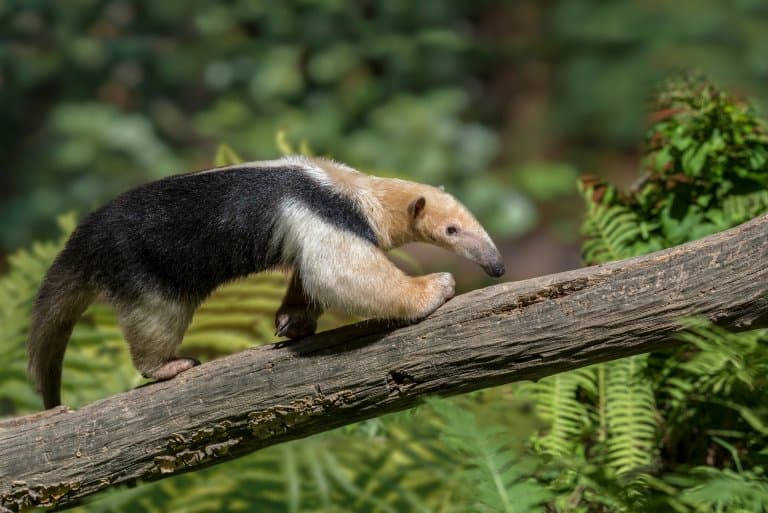
Northern Tamandua Facts Overview
| Habitat: | Forest and Savana |
| Location: | Central America, and NW South America |
| Lifespan: | Around 10 years in captivity |
| Size: | 1.3m (51 inches) long |
| Weight: | 5.7kg (12lb) |
| Colour: | Creamy brown with a dark vest |
| Diet: | Mostly ants and termites, sometimes other insects, fruit, |
| Predators: | Jaguars, large eagles |
| Top Speed: | Unknown |
| No. of Species: | 1 |
| Conservation Status: | Least Concern (IUCN) |
The name tamandua comes from the word ‘tamãdu’á’ in Tupi (an extinct language which was spoken by the aboriginal Tupi people of Brazil), which translates to ‘ant hunter’, while their suborder ‘Vermilingua’ means ‘worm-tongue’, referring to their famous long tongues.
The southern tamandua (or ‘lesser anteater’) is native to south America, and the island of Trinidad in the Caribbean. The nothern tamandua live in forests from south Mexico, central America and south America. The two species locations don’t overlap in the wild.
If the platypus had never been invented, the tamandua would be the focus of a lot more attention.
With its elongated polar bear head, mole claws and rat tail, it’s a mishmash of all sorts of animals, but each of these attributes serves an important role in the animal’s life as they’re adaptations to a specialised lifestyle.
While similar in appearance, northern tamanduas have a black ‘V’ pattern on their backs and vest on their torsos, while southern tamanduas can be partially vested, and lighter or darker in color.
Tamanduas are solitary, nocturnal creatures that will sleep in hollow tree trunks and burrows during the daytime and spend over half their time in the trees foraging for ants and termites.
Interesting Northern Tamandua Facts
1. Their tails are weird
You may have noticed a common theme among tree-dwelling animals with prehensile tails: they often have a bald spot. That’s because hair gets in the way of many things you need when gripping branches.
Grip, for one. But also, having bare skin against a branch allows for a much more detailed sensory experience, and this helps with coordination and navigation and all the skills that make one an arboreal master.
Tamandua tails are semi-prehensile, meaning they can’t pour a coffee with them, but they could give a decent hug. And this matches their semi-arboreal lifestyle – one in which the animal is equally comfortable on the ground as it is up in the canopy.
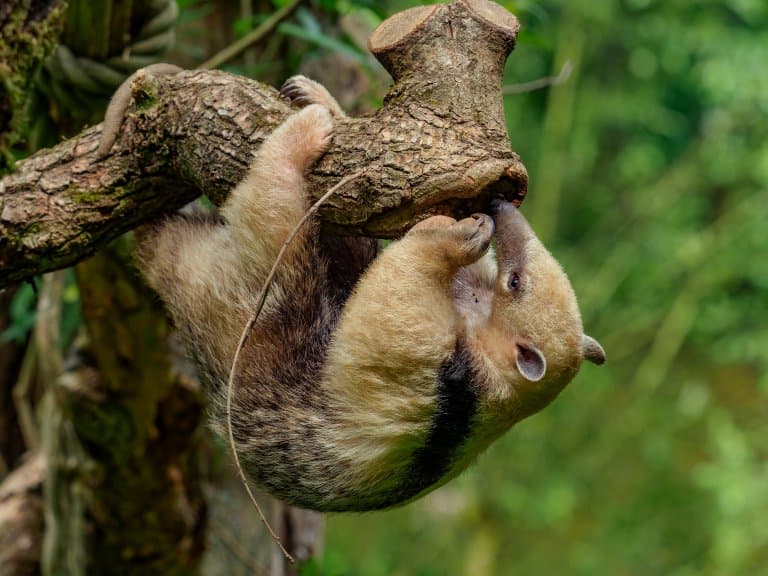
2. Their claws are formidable
As anteaters, they sport the classic talons used for ripping into the hardened mud structures their tiny meals build out of the earth.
These claws are large and powerful and can be upwards of 10cm (4 inches) long. They’re strong enough to climb with, too, and can give an attacker a nasty surprise if they get too close.
The claws likely also help the tamandua in its river crossings, something it is seemingly capable of with no trouble at all. They’re surprisingly good swimmers when they have to be, which makes them an all-terrain animal. 1
3. They have incredible tongues
Even longer than these claws are the specialised, elongated and sticky tongues, which can reach 40cm (16 inches) long, and are used to pull ants and termites up into their tubular mouths.
They’re so good at this, they can routinely get through 9,000 ants in a day!
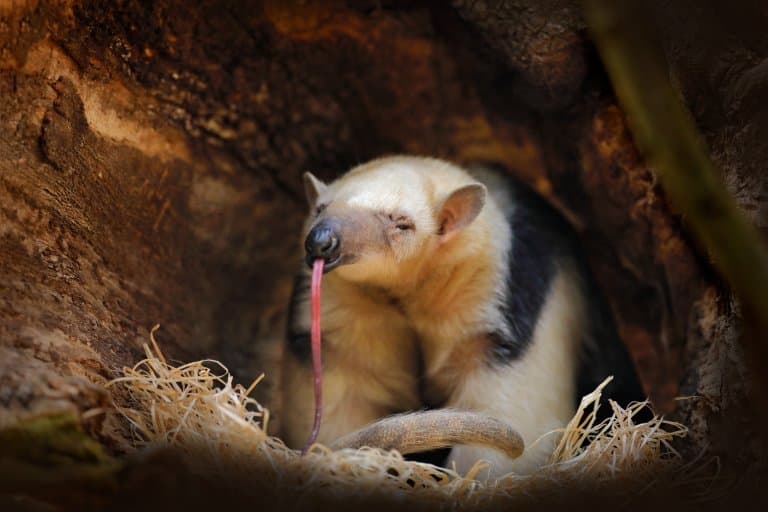
4. They’re obligate insectivores
This not only means they feel like they *should* eat insects, but it’s also a biological necessity for them. When an animal is referred to as an ‘obligate’ feeder of something specific, it means that it can only get important essential nutrients from that source.
Specialists are often obligated to eat one thing or another. Cats, for example, are obligate carnivores, meaning that must eat meat to survive.
The tamandua, being a specialist ant eater, must eat ants. And so it’s very fortunate that it lives in a place with lots of them.
5. But they still like a bit of fruit now and then
Being obligated to eat something doesn’t mean you’re limited to eating only that thing (the term for this is far less attractive: monophagous). So, while they must eat insects, tamanduas are more than happy to branch out where they can.
The trouble is, being so specialised to eat ants, they have some specific adaptations that make eating anything else a little difficult.
Their lack of teeth and fused, straw-like jaws does limit the satisfaction they can get out of a nice crunchy apple, but there are suggestions that they will slurp up the overripe flesh and juices of certain palm fruits in order to get some easy-access carbs to supplement an otherwise protein-rich diet.
This has been recorded in the wild and is common practice as part of their nutritional programs in captivity.
But, studying tamanduas in the wild is no easy task, and researchers will often use unorthodox methods to gather information on their physiology. 2
6. They walk on the sides of their forefeet
This is to avoid injuring their palms with their sharp claws. Tamanduas on the ground move around fairly awkwardly and can’t run like a giant anteater.
When threatened they will back up onto their rear legs and lash out with their forearms.
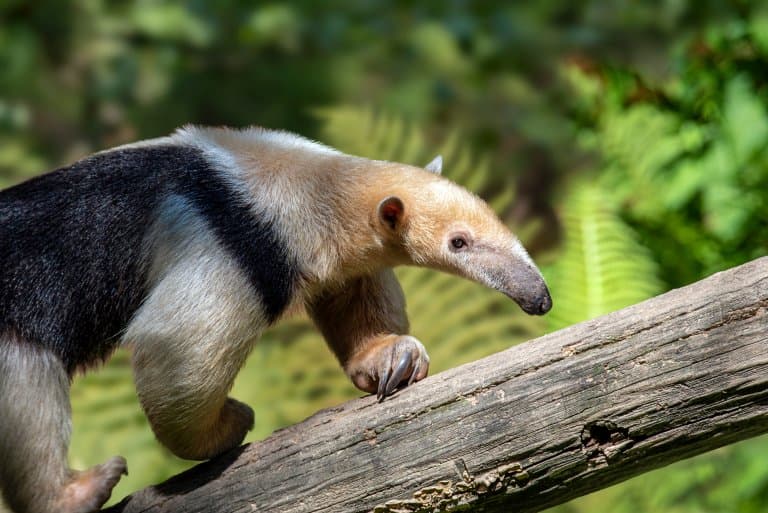
7. They make useful roadkill
Capturing live animals is difficult, dangerous, expensive and stressful to all involved, but given our impressive ability to run things over, humans have created various sampling gauntlets for researchers to find and study many species.
A tragically common way in which terrestrial animals can be surveyed cheaply and effectively is by sampling them from the side of the road.
To check things like disease vectors, researchers patrol roads in the tamandua’s range and hunt through the inevitable corpses to count the number of ticks and other parasites they were carrying.
This can give valuable data and is one way of making the best out of a bad situation, especially when there’s so little information available. 3
8. They’re pretty elusive
Sometimes we know exactly where a species lives and how many of them there are. Usually, the answer to most questions about these species is: it’s not looking good.
But sometimes there’s an animal whose whereabouts we sort of have an idea of, but any follow-up questions are met with a lot of trailing off and changing the subject.
The Northern Tamandua in particular is the latter. The IUCN lists it as “of least concern” under the assumption that they appear to be widespread and occupy some heavily-protected areas. But if you look any closer, you’ll see that this information is accompanied by a giant question mark (literally) for population trends and a shameless ignoring of the question of population figures.
This is both good and bad. There does appear to be enough information to establish that they’re not threatened yet, but there isn’t enough information to establish the scope of their threats.
These are not easy animals to study, and they most certainly are affected by the same habitat loss and hunting damage of any forest mammal in their range, the question is: how much? 4
9. They aren’t that appealing
Tamanduas are, like all mammals, made of meat. But unlike some unlucky animals, their fur isn’t very fun. This gives them an advantage over prettier animals when it comes to trophy or fur hunting, and may help save their lives.
They are cute though, which would put them high up on the pet trade list if it weren’t for their potent anal secretions – much like those of a skunk – that do a good job of keeping them off the Christmas list of wealthy children looking for a new companion.
Ultimately, though, there isn’t enough information available to confidently assert that these animals are doing fine, and there really needs to be more work on the topic to figure that out in order to be able to take a proactive approach to their conservation.
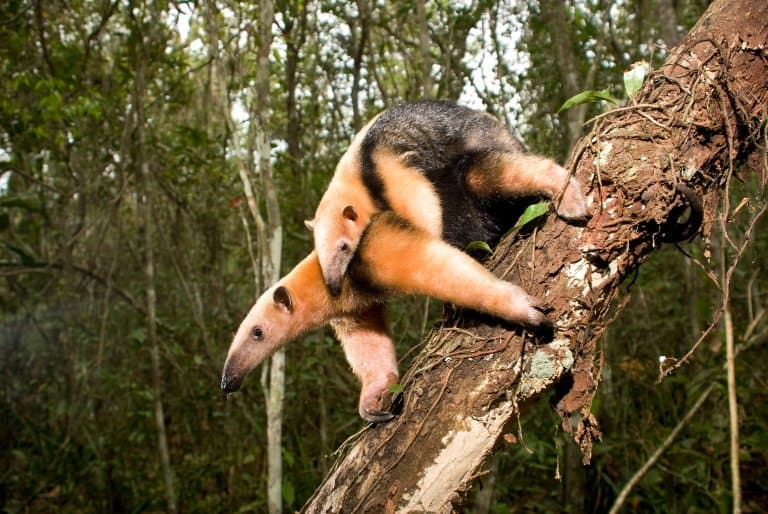
10. They are capable of being extremely smelly
At the base of their prehensile tail is a pair of special glands that can release a terrible smell.
This is used to mark territory and let other tamandua’s know of their presence in the area. It’s also used to ward off predators that get too close and works a lot like a skunk’s infamous defence.
The emission is said to be musky and earthy and they are on our smelliest animals in the world list.
11. They have been kept as pets by tribes
Amazonian native tribes have used the tamandua as a form of biological pest control, to get rid of pesky ants and termites from their huts.
While not advised and it’s not illegal, they are also sometimes kept as exotic pets, and will cost between $3,000 – 8,000 on the market.
Northern Tamandua Fact-File Summary
Scientific Classification
| Kingdom: | Animalia |
| Phylum: | Chordata |
| Class: | Mammalia |
| Order: | Pilosa |
| Family: | Myrmecophagidae |
| Genus: | Tamandua |
| Species: | Tamandua tetradactyla (Northern tamandua) |
Fact Sources & References
- Daya Navarrete (2011), “Tamandua mexicana (Pilosa: Myrmecophagidae)”, Oxford Academic.
- Danielle D. Brown (2011), “Fruit-Eating by an Obligate Insectivore: Palm Fruit Consumption in Wild Northern Tamanduas (Tamandua mexicana) in Panamá”, BioOne Digital Library.
- Claudia Irais Muñoz-García (2019), “Epidemiological study of ticks collected from the northern tamandua (Tamandua mexicana) and a literature review of ticks of Myrmecophagidae anteaters”, Science Direct.
- “Northern Tamandua”, IUCN Red List.
